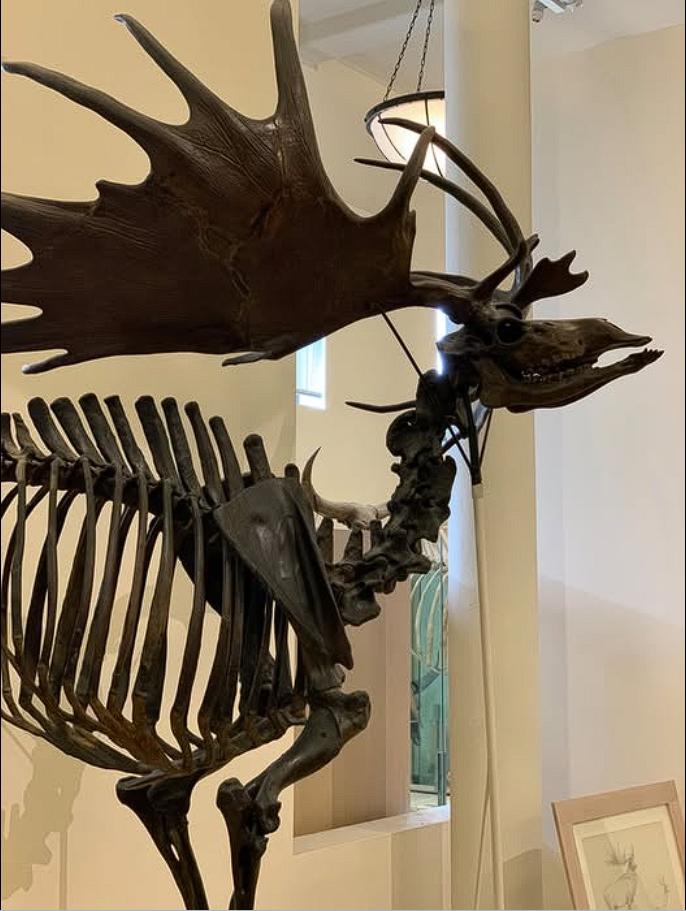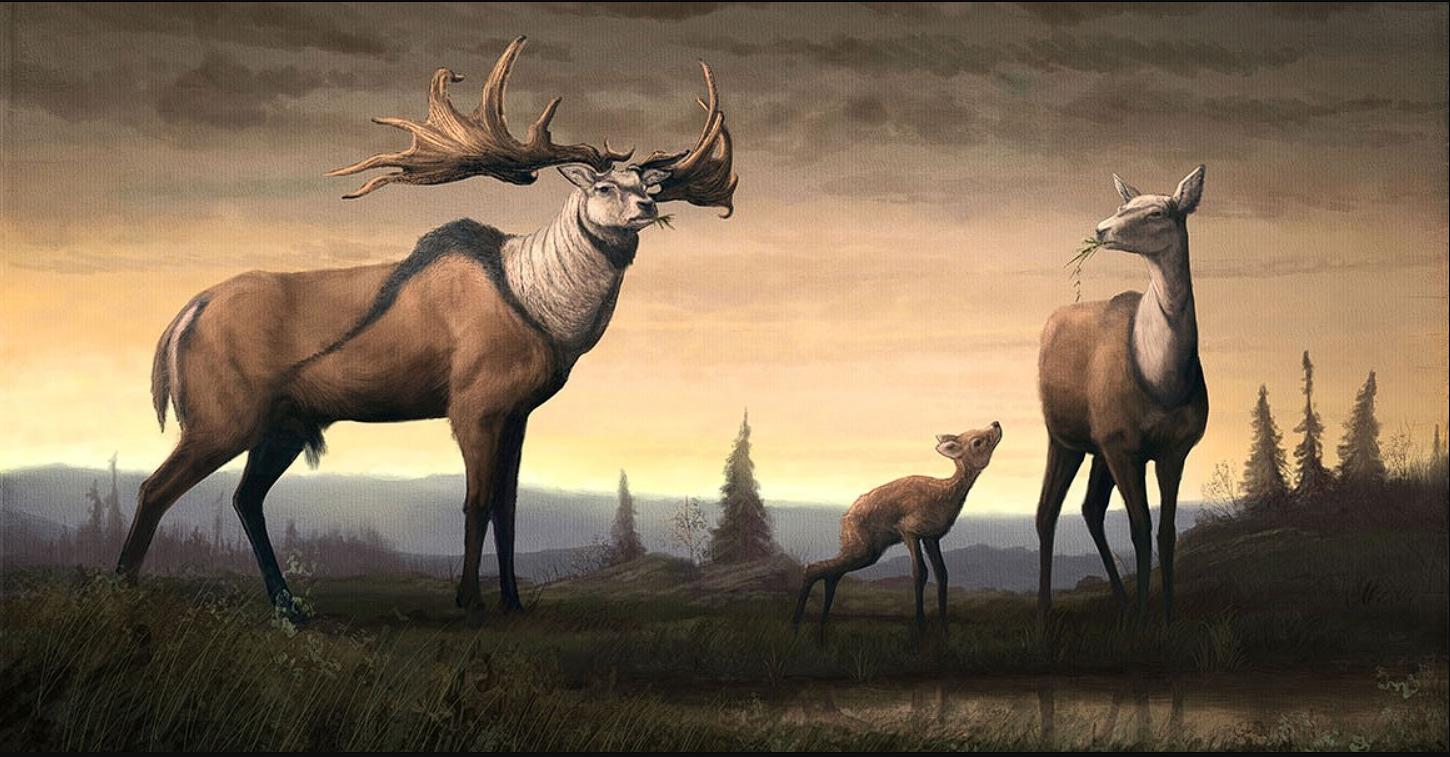The Irish Elk, scientifically known as Megaloceros giganteus, was a magnificent creature that roamed the earth during the Pleistocene epoch. Renowned for its colossal antlers, this giant deer species left a lasting impression on paleontology and continues to fascinate researchers and enthusiasts alike.
The Majestic Presence of the Irish Elk
The Irish Elk’s impressive size and distinctive antlers made it a dominant figure in its prehistoric environment.
Gigantic Size and Weight
The Irish Elk was one of the largest deer species ever to exist, boasting a size and weight that commanded respect.

- 1,500 Pounds Weight:
- Weighing up to 1,500 pounds (680 kg), the Irish Elk was a true giant, surpassing the size of modern deer species.
- It weighed 1,500 pounds.
- Dominant Species:
- Its massive size contributed to its dominance in its ecosystem, allowing it to thrive in diverse habitats.
- It was a dominant species.
- Prehistoric Giant:
- The Irish Elk’s designation as a prehistoric giant underscores its impressive stature and its role as a key species in the Pleistocene epoch.
- It was a prehistoric giant.
Astonishing Antlers
The Irish Elk’s most distinctive feature was its massive antlers, which could span an astonishing 13 feet (4 meters).
- 13-Foot Antler Span:
- The 13-foot antler span made it one of the most recognizable prehistoric animals, captivating the imagination of researchers and the public alike.
- It had a 13-foot antler span.
- Display and Dominance:
- These impressive antlers served not only as a display of strength but also played a crucial role in battles for dominance among males.
- The antlers were for display and dominance.
- Evolutionary Marvel:
- The evolution of such large antlers is a marvel of natural selection, highlighting the adaptive pressures faced by the Irish Elk.
- It was an evolutionary marvel.
Role in Battles for Dominance
The Irish Elk’s massive antlers were not just for show; they played a crucial role in battles for dominance among males.
- Male Competition:
- The antlers were used in male competition for mates, showcasing the intense rivalry and physical strength required for reproduction.
- The antlers were used in male competition.
- Physical Strength:
- The ability to wield such large antlers required immense physical strength, reflecting the robust nature of the Irish Elk.
- It required physical strength.
- Evolutionary Pressure:
- The evolutionary pressure to develop and maintain such large antlers highlights the importance of dominance in the Irish Elk’s social structure.
- It shows evolutionary pressure.
Geographical Distribution and Extinction
The Irish Elk’s geographical distribution and eventual extinction offer valuable insights into the environmental changes and challenges faced by prehistoric species.
Widespread Across Europe and Asia
The Irish Elk once roamed across a vast territory, spanning western Europe and extending as far east as China.

- Western Europe Habitat:
- Western Europe provided a favorable habitat for the Irish Elk, with diverse landscapes and abundant resources.
- It lived in western Europe.
- Eastward Expansion:
- Its eastward expansion to China highlights its adaptability and ability to thrive in a variety of environments.
- It expanded eastward.
- Pleistocene Distribution:
- The widespread distribution of the Irish Elk during the Pleistocene epoch underscores its success as a species in a changing world.
- It had Pleistocene distribution.
Disappearance Around 10,000 Years Ago
The Irish Elk disappeared from most of its range around 10,000 years ago, marking the end of its presence in many regions.
- End of Pleistocene:
- The end of the Pleistocene epoch brought significant environmental changes, contributing to the decline and eventual extinction of the Irish Elk in many areas.
- The Pleistocene ended.
- Environmental Changes:
- Changes in climate, vegetation, and habitat likely played a role in the Irish Elk’s disappearance, highlighting the impact of environmental shifts on large mammals.
- Environmental changes impacted it.
- Extinction Factors:
- The exact factors contributing to its extinction are still debated, with theories ranging from climate change to human hunting.
- Extinction factors are debated.
Survival in the Ural Mountains
A small population of Irish Elk managed to persist in the Ural Mountains until about 7,770 years ago, surviving well beyond the end of the Pleistocene.
- Ural Mountains Refuge:
- The Ural Mountains provided a refuge for a small population of Irish Elk, allowing them to survive longer than their counterparts in other regions.
- The Ural mountains were a refuge.
- Late Survival:
- Surviving until about 7,770 years ago indicates a remarkable ability to adapt to changing conditions and persist in isolated environments.
- It survived late.
- Post-Pleistocene Survival:
- This late survival beyond the end of the Pleistocene highlights the resilience of some Irish Elk populations and their ability to withstand environmental pressures.
- It survived post-Pleistocene.
The Enduring Legacy of the Irish Elk
The Irish Elk’s legacy extends beyond its physical presence, inspiring scientific research and capturing the imagination of the public.
Paleontological Significance
The Irish Elk holds significant paleontological significance, providing valuable insights into the evolution and extinction of large mammals.
- Evolutionary Insights:
- Studying the Irish Elk provides valuable insights into the evolutionary processes that shaped large mammals during the Pleistocene epoch.
- It provides evolutionary insights.
- Extinction Studies:
- Its extinction serves as a case study for understanding the factors that contribute to the decline and disappearance of species.
- It is used in extinction studies.
- Fossil Records:
- The rich fossil records of the Irish Elk offer a wealth of information for researchers studying prehistoric animals.
- It has rich fossil records.
Public Fascination
The Irish Elk’s impressive antlers and massive size continue to captivate the imagination of the public, making it a popular subject in museums and educational materials.
- Museum Displays:
- Museum displays featuring Irish Elk skeletons and antlers attract visitors, showcasing the grandeur of this prehistoric species.
- It is featured in museum displays.
- Educational Materials:
- The Irish Elk is often featured in educational materials, introducing students to the wonders of paleontology and prehistoric life.
- It is used in educational materials.
- Cultural Icon:
- Its iconic image has made it a cultural icon, representing the majesty and mystery of the prehistoric world.
- It is a cultural icon.
Scientific Research
The Irish Elk remains a subject of ongoing scientific research, with studies focusing on its evolution, extinction, and ecological role.
- Ongoing Studies:
- Ongoing studies continue to explore the factors that contributed to the Irish Elk’s extinction, providing new insights into its biology and ecology.
- It is subject to ongoing studies.
- Climate Change Impact:
- Research into the impact of climate change on the Irish Elk provides valuable information for understanding the effects of environmental shifts on modern species.
- Studies focus on climate change impact.
- Genetic Analysis:
- Advances in genetic analysis offer new opportunities to study the Irish Elk’s DNA, revealing its evolutionary history and genetic adaptations.
- Genetic analysis is used.
The Irish Elk, with its massive antlers and impressive size, remains a symbol of the prehistoric world’s grandeur. Its legacy continues to inspire scientific research and captivate the imagination of the public, highlighting the importance of understanding and preserving our planet’s natural history.

CÁC TIN KHÁC
Mary Walton: The Forgotten Inventor Who Helped Clean Up America’s Cities
Tomb of Queen Nefertari in the Valley of the Queens, Egypt
Discover the Hypostyle Hall of the Temple of Hathor at Dendera
Venus de Losange: Unveiling the Mystery of a 20,000-Year-Old Paleolithic Icon